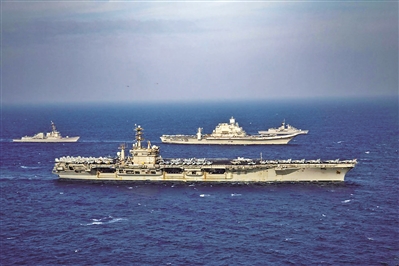
By Zhang Ning
The Australian Prime Minister Scott Morrison visited Japan in November 17 and 18, during which the most watched topic was whether the two countries would sign the Reciprocal Access Agreement (RAA) defence pact that has been under negotiation for 6 years. Although they didn’t sign the agreement in the end, discussions around it remained the top priority in the meeting between Morrison and his Japanese counterpart Yoshihide Suga.
Japan’s Kyodo News reported that Japanese and Australian prime ministers reached a consensus on intensifying security cooperation and they said at the joint press conference later that an “in-principle agreement” had been reached on signing the RAA. The meeting marked a major step toward reaching an in-principle agreement on the historic defence pact of RAA, said Morrison.
The RAA, formerly known as Visiting Forces Agreement (VFA), has been called by some media as a “breakthrough defence pact” that will establish a legal framework to allow Japanese and Australian troops to visit each other's countries and conduct training and joint operations with much less administration. Once the pact is signed, Australia will become the second country after the US, which signed the "Status of Forces Agreement" (SOFA) with Japan in 1960, to sign such a pact with Japan, further strengthening the military ties between the two US allies.
Tokyo and Canberra have continuously intensified their military relationship in recent years. In 2007, they signed a military cooperation agreement that allowed the two countries to carry out joint military exercises and formal military exchanges and allowed the Japanese Self-defense Forces to conduct anti-terror training in Australia. In 2012, they signed an intelligence security pact to share military intelligence. In 2014, they signed an accord on defense, science and technology to facilitate defense technology cooperation between the two countries. Since then, their military cooperation has expanded to sharing military supplies and other necessities after Japan relaxed its restriction on weapon and equipment export.
The latest move of intensifying military cooperation between Tokyo and Canberra is worth high vigilance from regional countries.
On the one hand, the RAA deviates from the spirit of the Japanese Peace Constitution, in which Article 9 of Chapter II states that the Japanese people forever renounce war as a sovereign right of the nation and the threat or use of force as a means of settling international disputes. In order to accomplish the aim of the preceding paragraph, land, sea and air forces, as well as other war potential, will never be maintained. The right of belligerency of the state will not be recognized. The Japanese Constitution is called the Peace Constitution because of this article.
Although the Peace Constitution is supported by the mainstream public opinions in Japan, some right-wing political forces have always attempted to get rid of it through constitutional amendment. Among former Japanese prime ministers, Yasuhiro Nakasone and Shinzo Abe separately set the goal of building Japan into a political and military power. The incumbent Prime MinisterYoshihideSuga, who inherits Abe’s political stance and view, has even refused to admit “anti-constitutional amendment”scholars into the Science Council of Japan, the country’s top academic institution, in order to escort his plan to amend the constitution, a move that has infuriated the academic circle.
If Japan and Australia assign troops to or build military bases in each other’s countries according to RAA, it would be a de facto violation of the Peace Constitution and further clear the way for Japan’s military ambitions. British newspaper Guardian reported that countries including the UK are also waiting for the final outcome of the RAA, which may serve as a template for Japan to reach similar pacts with other countries in the future.
On the other hand, a real military alliance between Japan and Australia, both of which are America’s allies, will exert substantial negative impacts on regional geopolitics. Washington has been trying very hard to peddle its so-called “Indo-Pacific Strategy” in Asia over recent years, and military cooperation among the US, Japan, India and Australia has become increasingly active. Against such a background, the intensified Japan-Australia military cooperation will bring more uncertainties to the Asia-Pacific and threaten regional peace and security.













